After having got a sense of Tokyo and Kyoto metropolises in central Japan, I wish experiencing the spirit of the last frontier.
The Yaeyama archipelago in Okinawa prefecture constitutes the southwestern corner of the country, no less than 1,615 km away from Kyoto. From there, a direct flight takes two and half hours to reach by air Ishigaki – the main town in Yaeyama archipelago.
Yaeyama islands nurture a peculiar collective identity. Indigenous people are Okinawan first, then and possibly marginally Japanese. The Yaeyama dialect constitutes the vernacular language, while Japanese language comes only second.
Deep into the Pacific Ocean, the Yaeyama islands are home to many subtropical plants and mangrove forests. Coral reefs circling the islands host a rich sea life including dolphins, turtles and sharks. In the past, marine mammals such as whales and dugongs were common as well. This is a volcanic area. Close to Iriomote island is an active undersea volcano that last erupted in 1924.
I visit two islands of Yaeyama archipelago – Iriomote and Taketomi.
Iriomote
Iriomote is the largest island of the Yaeyama archipelago with a surface area of 290 sq km. Along with the rest of Okinawa prefecture, Iriomote was under US control from World War II until 1972.

I board a ferryboat, as regular access to the island is possible by sea only. Then a bus takes me very conveniently to my Okinawan home stay (minshuku). Internal regulations of the house are as many and detailed as in a monastery, but food is great.

I rent a bicycle for my mobility. Void of airport, Iriomote is also scarce on road network. Infrastructure consists in a single coastal road connecting the hamlets along the shores. No roads run into the unspoiled inland.

Iriomote is covered by dense jungle and mangrove swamps, of which one third forms the Iriomote National Park. Hiking, cycling and kayaking are common sport inland activities.

On my first journey, I cycle to the mouth of the Urauchi-gawa River. From there, I board a boat heading upstream far into the inland, crossing beautifully wild landscapes. We are allowed a two-hour trek on our own along the river, before returning to the river mouth.



Back to the base, I enquire about a one-day trek crossing the island in its width – the supreme hike of the island. I drop the plan due to the astronomic fees requested by the guide. Too bad!
Never mind. In the following days, I explore the shores of the island, getting into lagoons and swamps as much as possible. Again, my camera unveils awesome natural sceneries.



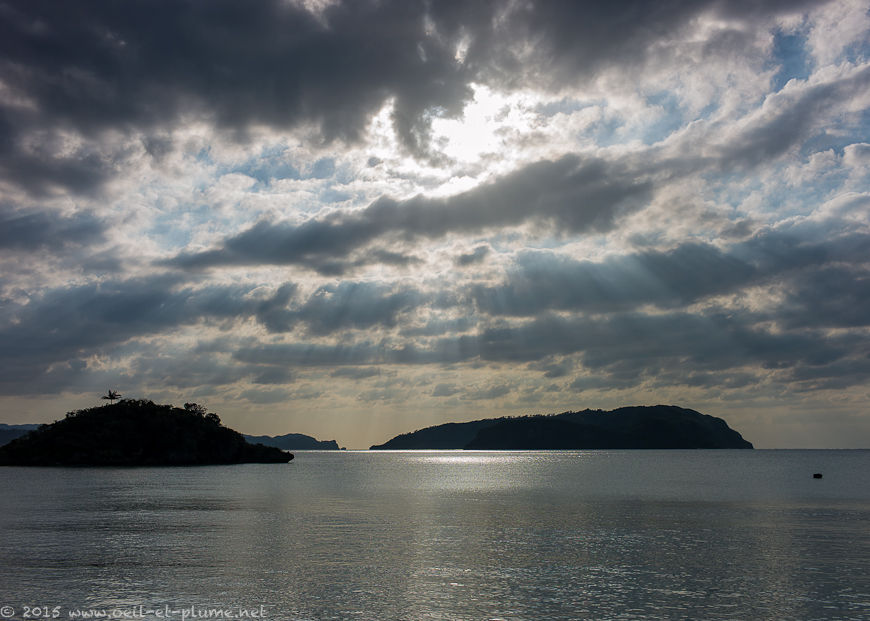
On my last day, I head to Shirahama port. Don’t expect a major seaport there. Iriomote is sparsely populated, counting some 2,500 residents only. They rely mainly on fishing and farming for their living.



I am also to board a boat, in order to visit Funauki settlement, accessible only by sea. From there, a short trek brings me to the gorgeous Ida-no-hama beach.



You will have noticed my high energy. Japanese food made me so strong!
The island is famed for the Iriomote cat, a subspecies of the leopard living only there. The Iriomote cat is critically endangered as there are only an estimated 100 individuals left. They are nocturnal and particularly active during twilight hours. By daytime, they rest in shaded areas.
From the background information above, you have rightly guessed that it is extremely difficult to cross any Iriomote cat. Believe it or not, I did meet one of them – by daytime. This was an unexpected and short encounter in a wild path close to the seashore in the northwest corner of the island.
I am trekking, struggling to cross the dense vegetation. All of the sudden, I spot a big wildcat ahead, about ten meters away. Both of us stay still in a mixture of surprise, observation and fear. Following a brief eye-to-eye contact, the Iriomote cat jumps and hides in the jungle. I remember my camera in my hand only after the wildcat is out of sight…

Wildlife photography is not my cup of tea, you will think. True, I prefer people’s photography. However and in order to boost my self-esteem, I manage to collect evidence of my encounter with the Iriomote cat before leaving the island. Above are his cute face and his paw prints.
Taketomi
Taketomi island is a little gem nested close to Ishigaki. The 5.5 sq km coral atoll is nearly circular in shape and circled by coral reefs. It hosts some 320 residents but many more visitors. Most of them stay in couple of hours before returning to Ishigaki. I stay three days to get deeper into its beautiful microcosm.
Taketomi is cute both inland and all around it. One beach counts plenty of ‘star-sand’ (hoshisuna), i.e. star-shaped skeletons of tiny organisms living in the sea grass.

More importantly for me, Taketomi is famous for its traditional Okinawan houses, rocky walls and sandy streets.
The island hosts almost only traditional one-storied houses. The renovation and the construction of premises are strictly regulated to preserve the historical legacy and the charm of the island.
There is one notable exception to Taketomi’s conservatory concern: the red-tiled house roofs represent a 20th century architectural feature, replacing advantageously the traditional thatched covers.
Taketomi’s streets are made of shiny and white crushed coral dust contrasting with the vividly coloured gardens surrounding the houses. Imposing walls of natural stones enclose the houses themselves.





Shinto and Buddhist deities are all around, sometimes boldly visible but mostly discrete. Fierce shisa (lion/dog shaped stone figures) throne on most of the rooftops or on stone walls upper edges, keeping the house safe from evil spirits and other intruders.

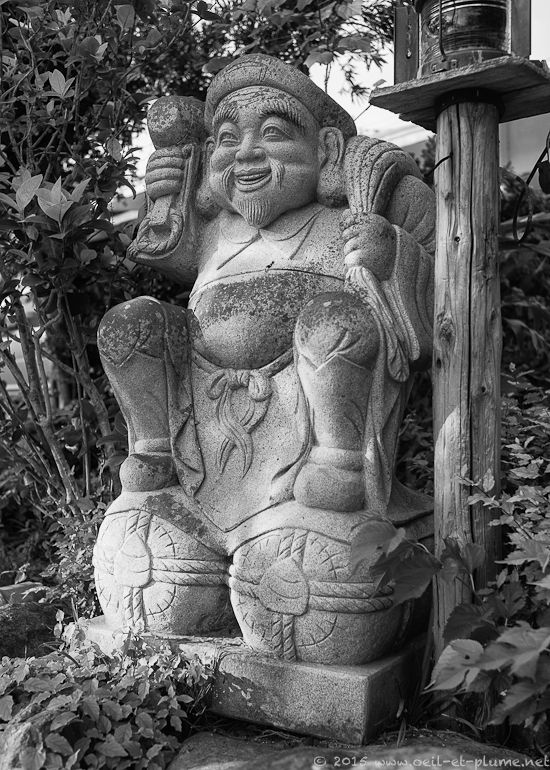
I spend much time decoding the complex set of cultural signs, visiting the shrines and other religious places accessible to outsiders. Unlike Japan’s mainland, Taketomi’s islanders practice their religion in private.



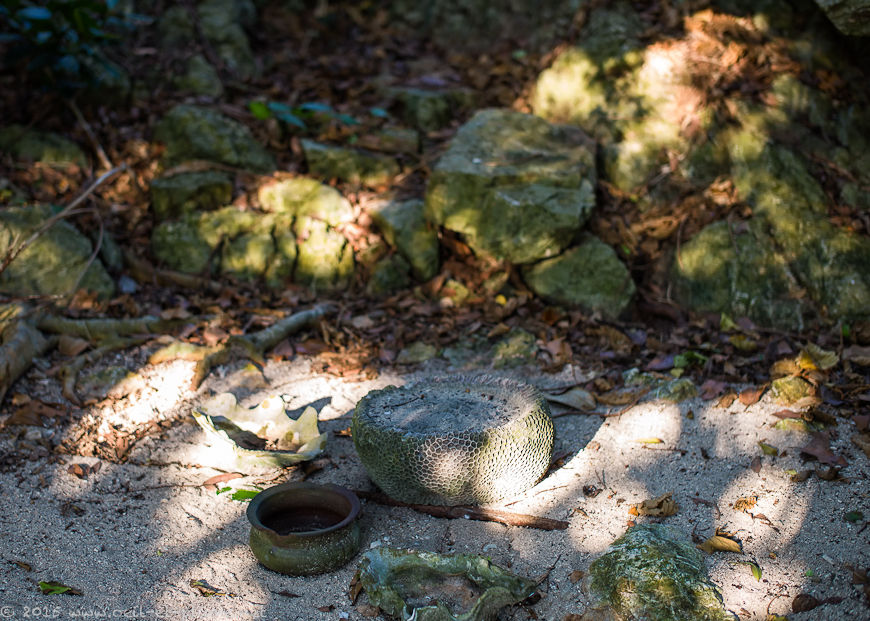
As always in Japan, one senses the strong connection nurtured between human and natural life through spirituality exerted in daily life. I like this very much.
Beside hiking or cycling around and across the island, the most popular tourist activity consists in an ox-cart ride through the village. Oxen and their coachmen spend all day waiting for passengers and touring them across the village.
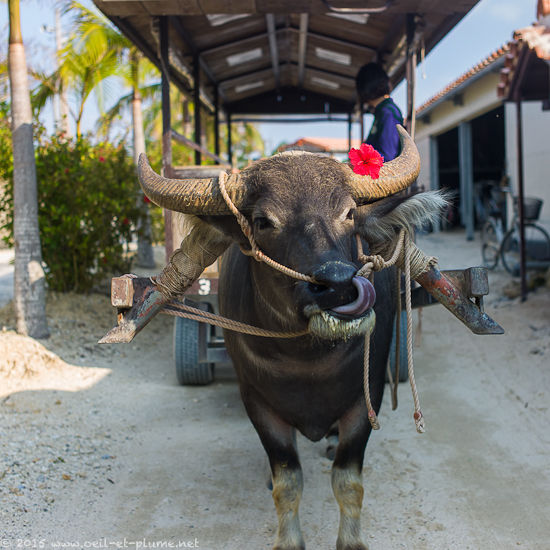


On the way, vintage Okinawan melodies are played on a local guitar. Romantic indeed to enjoy the quaintness of the place, but too touristy for a globetrotter…
The daytime tourism disappears in late afternoon with the departure of the last ferry returning to Ishigaki. Oxen are being fed while the sand streets are meticulously swept before the night. Yes, we are in Japan.

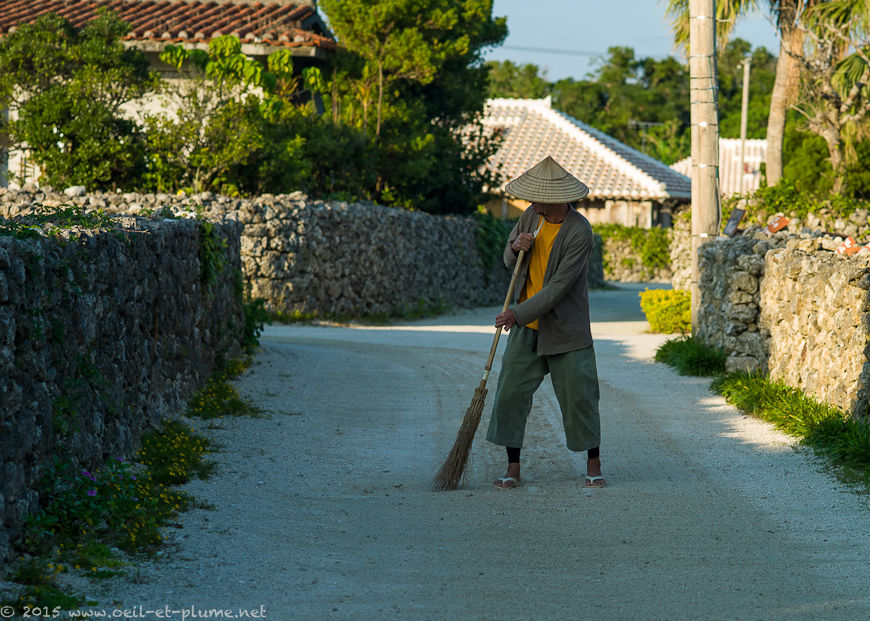
In the evening, Taketomi becomes blissfully quiet and nearly silent. Only guesthouses distil some low noise during dinnertime. Wait: there is even some music and a party over there!


Unfortunately, Okinawan music is not to everybody’s taste. Two fundamental reactions are possible: fury or advocacy, both aiming at stopping the musical disaster.



Don’t worry; Okinawan music is not that bad in reality.
Taketomi is also not a nightlife spot. Later in the evening, the village is absolutely silent. It is not without charm if you step out to look at the Okinawan stars of the Pacific Ocean. Yes, even a globetrotter can be romantic.
Japan’s connoisseurs will agree that Japanese people are full of fantasy and humour, despite all clichés prevailing about them. The shisas above only confirm the point. Still unconvinced? Look hereafter:

The pair aims possibly at boosting Taketomi’s resident population, which barely exceeds 300 individuals. There are hints that the demographic growth strategy may work out.

Okay, this is not a wedding dress, but I bet that this beautiful Japanese girl will not stay single for long anymore.
Cheers,